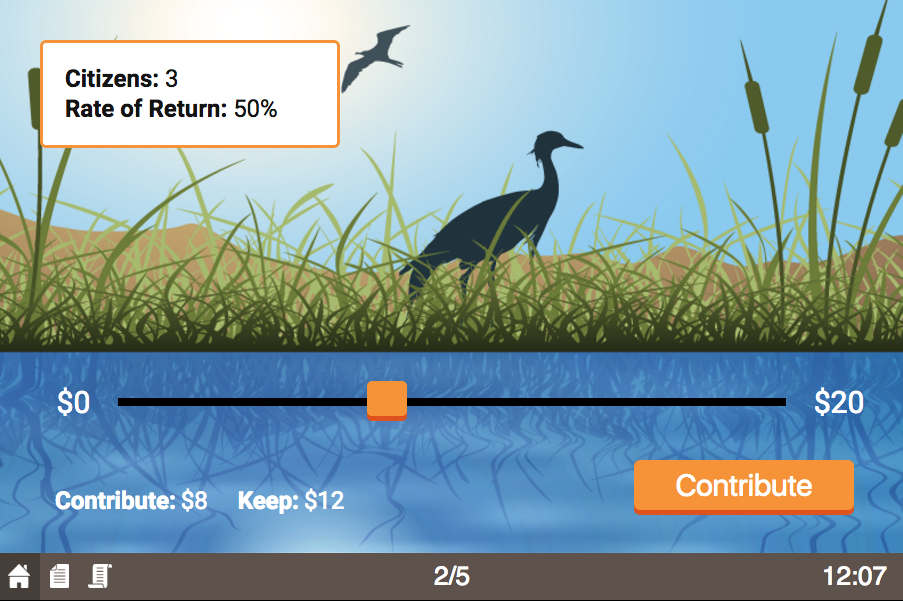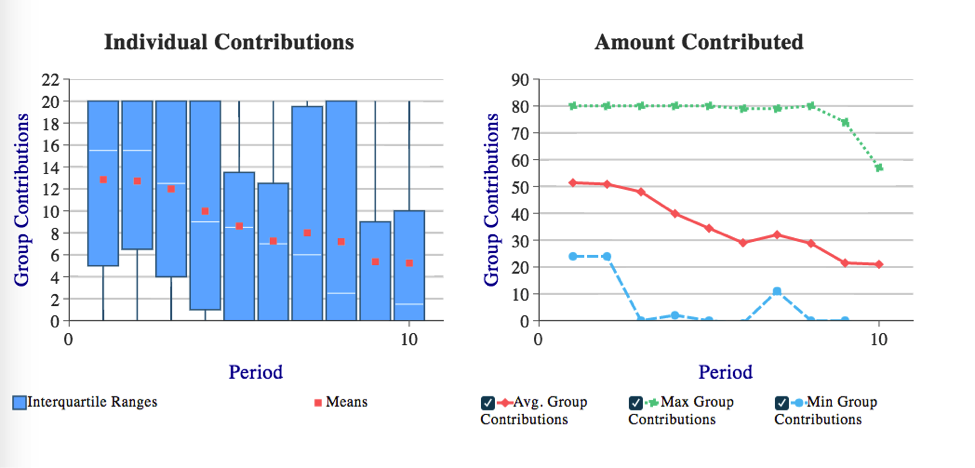What is a public good? The definition of a public good is one that is “non-excludable” (i.e. individuals cannot be prevented from consumption) and “non-rivalrous (i.e. one person’s consumption does not reduce what is available for another to consume). Classic examples include radio signals, national defense, ideas, and fireworks to name a few. In 1919, Swedish economist Erik Lindahl came up with a nice mathematical solution to finance these public goods. But, it relied on people to report to their government their value of the public good. Of course this is a problem. As Samuelson (1954) notes in his classic public goods paper,“But, and, this is the point sensed by Wicksell but perhaps not fully appreciated by Lindahl, now it is in the selfish interest of each person to give false signals, to pretend to have less interest in a given collective consumption activity than he really has, etc.”In other words, we shouldn’t assume people are angels. The fact that there is no great mechanism to truthfully reveal demand for a public good means that many public goods have relied on donations rather than set prices. As Vernon Smith notes in his 1980 AER article titled, “Experiments with a Decentralized Mechanism for Public Goods Decisions”, “Thousands of churches, music halls, libraries, scientific laboratories, art museums, theatres, and other such facilities have been financed by voluntary contributions to fund drives conducted by private societies.”But, that doesn’t mean that relying on donations doesn’t come with its own problems. One of the most common settings to capture the incentive problems of relying on donations is called the Linear Public Goods Game (the game popularized by one of my best friends and dissertation chair Mark Isaac). In the Linear Public Goods Game a student is embedded in a group of several other students. Each student has a budget and can “Keep” some fraction of that budget for themselves and/or “Contribute” some fraction of that budget to the public good. For each dollar the student “Keeps” they receive a dollar (a one-to-one return). For each dollar the student “Contributes” they receive a payment equal to the sum of all contributions by other group members multiplied by a number less than one (the default is .50 or 50 percent). They receive payment from the public good regardless of whether they contributed to fund it. Suppose there were four total group members, each with a $20 budget, and a .50 multiplier on the public good (as described above). Think for a moment, what would be best for the group? What would be best for you individually?You can see there is a tension between what is best for the individual and what is best for the group! If everyone contributed their $20 to the group account each person would receive .50*($20 + $20 + $20 + $20) = $40 for a total of $160 of earnings for the group. However, you might notice that you could earn more money if everyone else in the group contributes all their $20 but you free ride. Your payment from the $20 you kept is $20. Plus, you get .50*($20 + $20 + $20) = $30 from the public good. In total you earn $50. This incentive to deviate is strong. Plus, others might also deviate. And, if everyone deviates but you contribute then you actually earn $10. Less than what you started with!In these kinds of games cooperation generally starts out between 40 and 60 percent of the maximum. However, cooperation is fragile and the incentives described above often take hold after a few rounds. In fact, I did a quick search of some data from a recent public goods game. This was the first game I found (no cherry picking). The maximum group contributed at a high level for a while but then with a finite end period the writing was on the wall and backward induction took hold. The minimum group struggled almost the whole time. But, on average the prediction I gave held. Contributions started at 62.5 percent of the maximum and declined to 25 percent across rounds.
Suppose there were four total group members, each with a $20 budget, and a .50 multiplier on the public good (as described above). Think for a moment, what would be best for the group? What would be best for you individually?You can see there is a tension between what is best for the individual and what is best for the group! If everyone contributed their $20 to the group account each person would receive .50*($20 + $20 + $20 + $20) = $40 for a total of $160 of earnings for the group. However, you might notice that you could earn more money if everyone else in the group contributes all their $20 but you free ride. Your payment from the $20 you kept is $20. Plus, you get .50*($20 + $20 + $20) = $30 from the public good. In total you earn $50. This incentive to deviate is strong. Plus, others might also deviate. And, if everyone deviates but you contribute then you actually earn $10. Less than what you started with!In these kinds of games cooperation generally starts out between 40 and 60 percent of the maximum. However, cooperation is fragile and the incentives described above often take hold after a few rounds. In fact, I did a quick search of some data from a recent public goods game. This was the first game I found (no cherry picking). The maximum group contributed at a high level for a while but then with a finite end period the writing was on the wall and backward induction took hold. The minimum group struggled almost the whole time. But, on average the prediction I gave held. Contributions started at 62.5 percent of the maximum and declined to 25 percent across rounds. The public goods game is a great illustration of the tension that exists in real world donation scenarios. An interesting question to follow up with students about is what factors might be involved in some groups succeeding while other groups fail. In fact, cutting them loose on that question might really get them excited about economics. I know when my advisor, Mark Isaac asked me that question over ten years ago, it got me excited.
The public goods game is a great illustration of the tension that exists in real world donation scenarios. An interesting question to follow up with students about is what factors might be involved in some groups succeeding while other groups fail. In fact, cutting them loose on that question might really get them excited about economics. I know when my advisor, Mark Isaac asked me that question over ten years ago, it got me excited.
 Suppose there were four total group members, each with a $20 budget, and a .50 multiplier on the public good (as described above). Think for a moment, what would be best for the group? What would be best for you individually?You can see there is a tension between what is best for the individual and what is best for the group! If everyone contributed their $20 to the group account each person would receive .50*($20 + $20 + $20 + $20) = $40 for a total of $160 of earnings for the group. However, you might notice that you could earn more money if everyone else in the group contributes all their $20 but you free ride. Your payment from the $20 you kept is $20. Plus, you get .50*($20 + $20 + $20) = $30 from the public good. In total you earn $50. This incentive to deviate is strong. Plus, others might also deviate. And, if everyone deviates but you contribute then you actually earn $10. Less than what you started with!In these kinds of games cooperation generally starts out between 40 and 60 percent of the maximum. However, cooperation is fragile and the incentives described above often take hold after a few rounds. In fact, I did a quick search of some data from a recent public goods game. This was the first game I found (no cherry picking). The maximum group contributed at a high level for a while but then with a finite end period the writing was on the wall and backward induction took hold. The minimum group struggled almost the whole time. But, on average the prediction I gave held. Contributions started at 62.5 percent of the maximum and declined to 25 percent across rounds.
Suppose there were four total group members, each with a $20 budget, and a .50 multiplier on the public good (as described above). Think for a moment, what would be best for the group? What would be best for you individually?You can see there is a tension between what is best for the individual and what is best for the group! If everyone contributed their $20 to the group account each person would receive .50*($20 + $20 + $20 + $20) = $40 for a total of $160 of earnings for the group. However, you might notice that you could earn more money if everyone else in the group contributes all their $20 but you free ride. Your payment from the $20 you kept is $20. Plus, you get .50*($20 + $20 + $20) = $30 from the public good. In total you earn $50. This incentive to deviate is strong. Plus, others might also deviate. And, if everyone deviates but you contribute then you actually earn $10. Less than what you started with!In these kinds of games cooperation generally starts out between 40 and 60 percent of the maximum. However, cooperation is fragile and the incentives described above often take hold after a few rounds. In fact, I did a quick search of some data from a recent public goods game. This was the first game I found (no cherry picking). The maximum group contributed at a high level for a while but then with a finite end period the writing was on the wall and backward induction took hold. The minimum group struggled almost the whole time. But, on average the prediction I gave held. Contributions started at 62.5 percent of the maximum and declined to 25 percent across rounds. The public goods game is a great illustration of the tension that exists in real world donation scenarios. An interesting question to follow up with students about is what factors might be involved in some groups succeeding while other groups fail. In fact, cutting them loose on that question might really get them excited about economics. I know when my advisor, Mark Isaac asked me that question over ten years ago, it got me excited.
The public goods game is a great illustration of the tension that exists in real world donation scenarios. An interesting question to follow up with students about is what factors might be involved in some groups succeeding while other groups fail. In fact, cutting them loose on that question might really get them excited about economics. I know when my advisor, Mark Isaac asked me that question over ten years ago, it got me excited.
